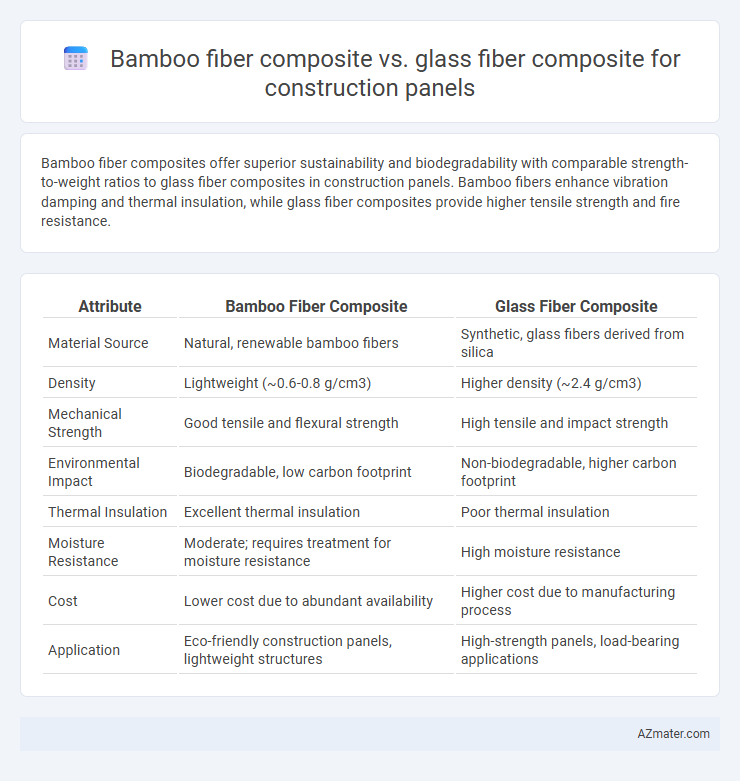Bamboo fiber composites offer superior sustainability and biodegradability with comparable strength-to-weight ratios to glass fiber composites in construction panels. Bamboo fibers enhance vibration damping and thermal insulation, while glass fiber composites provide higher tensile strength and fire resistance.
Table of Comparison
| Attribute | Bamboo Fiber Composite | Glass Fiber Composite |
|---|---|---|
| Material Source | Natural, renewable bamboo fibers | Synthetic, glass fibers derived from silica |
| Density | Lightweight (~0.6-0.8 g/cm3) | Higher density (~2.4 g/cm3) |
| Mechanical Strength | Good tensile and flexural strength | High tensile and impact strength |
| Environmental Impact | Biodegradable, low carbon footprint | Non-biodegradable, higher carbon footprint |
| Thermal Insulation | Excellent thermal insulation | Poor thermal insulation |
| Moisture Resistance | Moderate; requires treatment for moisture resistance | High moisture resistance |
| Cost | Lower cost due to abundant availability | Higher cost due to manufacturing process |
| Application | Eco-friendly construction panels, lightweight structures | High-strength panels, load-bearing applications |
Introduction to Composite Materials in Construction
Bamboo fiber composite offers a sustainable alternative to traditional glass fiber composite panels in construction, combining natural fibers with resin matrices to enhance strength and durability. These composites exhibit high tensile strength, lightweight properties, and excellent resistance to moisture and impact, making them ideal for eco-friendly building applications. Glass fiber composites remain favored for their superior stiffness and thermal stability, but bamboo fiber composites provide a renewable, biodegradable solution with comparable mechanical performance and reduced carbon footprint.
Overview of Bamboo Fiber Composite Panels
Bamboo fiber composite panels offer lightweight, high tensile strength, and excellent sustainability compared to traditional glass fiber composites used in construction. Their natural fibers provide superior biodegradability and reduced carbon footprint while maintaining adequate durability and moisture resistance for structural applications. Bamboo composites exhibit enhanced acoustic insulation and thermal properties, making them ideal for eco-friendly, energy-efficient building panels.
Overview of Glass Fiber Composite Panels
Glass fiber composite panels, widely used in construction, offer high tensile strength and excellent durability under various environmental conditions. These panels provide superior resistance to moisture, corrosion, and fire, making them ideal for structural applications and exterior cladding. Compared to bamboo fiber composites, glass fiber panels deliver enhanced load-bearing capacity and long-term stability, supporting their prevalent use in industrial and commercial building projects.
Mechanical Properties Comparison
Bamboo fiber composites exhibit high tensile strength and excellent flexural performance, making them lightweight yet durable options for construction panels. Glass fiber composites generally offer superior stiffness and higher impact resistance, but their heavier weight can limit ease of handling. Both materials demonstrate good mechanical properties, with bamboo fiber composites providing sustainable alternatives while maintaining competitive strength-to-weight ratios.
Environmental Impact and Sustainability
Bamboo fiber composites exhibit significantly lower carbon footprints compared to glass fiber composites due to bamboo's rapid renewability and its ability to sequester CO2 during growth. Glass fiber composites rely on energy-intensive manufacturing processes and non-renewable silica resources, leading to higher embodied energy and landfill persistence. Utilizing bamboo fiber composites in construction panels enhances sustainability by promoting biodegradability and reducing reliance on fossil fuel-derived materials.
Cost Analysis and Economic Feasibility
Bamboo fiber composites offer a cost-effective alternative to glass fiber composites in construction panels, with raw material costs typically 30-50% lower due to the rapid renewability and abundance of bamboo. Production processes for bamboo composites require less energy, reducing manufacturing expenses and carbon footprint, which enhances their economic feasibility in sustainable building projects. Despite slightly lower mechanical strength, the overall lifecycle cost savings and environmental benefits position bamboo fiber composites as a financially viable solution compared to traditional glass fiber panels.
Durability and Lifespan in Construction Applications
Bamboo fiber composites exhibit excellent durability in construction panels due to their natural resistance to moisture, pests, and UV degradation, contributing to a lifespan comparable to traditional materials. Glass fiber composites offer superior strength and resistance to corrosion, making them highly durable in harsh environmental conditions with an expected lifespan of 25-30 years. Bamboo fiber composites provide a sustainable alternative with competitive durability, while glass fiber composites remain preferred for high-load and long-term structural applications in construction.
Thermal and Acoustic Insulation Performance
Bamboo fiber composites exhibit superior thermal insulation due to their natural hollow fiber structure, which reduces heat transfer more effectively than glass fiber composites. Acoustic insulation is also enhanced in bamboo fiber composites, as their porous morphology absorbs and dampens sound waves better than denser glass fiber panels. These properties make bamboo fiber composites a sustainable and efficient choice for construction panels requiring high thermal and acoustic performance.
Fire Resistance and Safety Considerations
Bamboo fiber composites exhibit lower fire resistance compared to glass fiber composites due to their organic nature, leading to faster ignition and smoke production. Glass fiber composites offer superior flame retardancy, higher melting points, and reduced smoke toxicity, making them safer for construction panels in fire-prone environments. Safety considerations favor glass fiber composites for structural applications requiring stringent fire codes and prolonged exposure to high temperatures.
Future Trends and Adoption in Construction Industry
Bamboo fiber composites are gaining traction in the construction industry due to their sustainability, lower carbon footprint, and excellent mechanical properties compared to traditional glass fiber composites. Future trends indicate a shift towards bio-based materials as regulatory pressure and consumer demand for eco-friendly solutions increase, driving innovation in bamboo fiber processing and hybrid composite development. Enhanced durability, moisture resistance, and cost-effectiveness improvements are expected to accelerate adoption of bamboo fiber composites in structural panels and facade systems.

Infographic: Bamboo fiber composite vs Glass fiber composite for Construction panel
 azmater.com
azmater.com